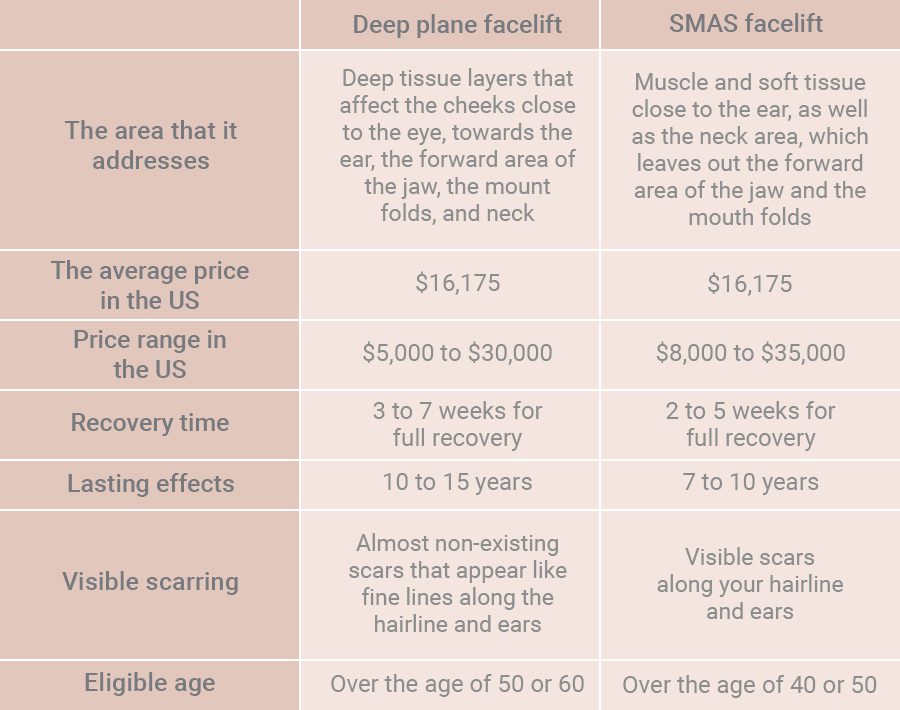Even in contemporary society, the saggy look that comes with aging isn’t easily accepted. Many people feel young and energetic despite how old they are, but their physical appearance may not match their self-concept. This way, many turn to facelifts. But what is a deep plane facelift?
Today, it’s the most wanted facelift procedure, but why is that so? Keep on reading to explore what is a deep-plane facelift and why surgeons worldwide support the procedure.
[ez-toc]

Source: shutterstock.com / Photo Contributor: Rustle
What Is a Deep Plane Facelift?
A deep plane facelift is a surgical cosmetic procedure in which deep facial tissue structures are repositioned. The deep tissue layer is known as the “superficial muscular aponeurotic system,” or SMAS. When surgeons tighten the SMAS, they potentially help you attain a lifted appearance by tightening the sagging skin around the cheek, jaws, and neck area.
A proper skincare routine can reduce the appearance of fine lines, wrinkles, and sagging skin, yet factors like gravity, genetics, and environmental stressors can affect our skin, but deep plane facelift aside from giving you an energetic and youthful appearance, deep plane facelifts may help with filling out any hollowness around the eyes due to aging. Moreover, this procedure may readjust the cheek back to its rightful place, giving you high cheekbones for days.

Source: shutterstock.com / Photo Contributor: n.k.junky
The history behind deep plane facelift
Facelifts have been and still are very popular among the pro-plastic surgery community. Facelifts are surgical procedures that are done to erase years off of a person’s face by smoothing out wrinkles and tightening the saggy skin around the jaw and neck.
There are multiple variations of facelifts, such as subperiosteal, tri-planar, SMAS, and deep plane facelifts. As of today, SMAS and deep plane facelifts are the most popular among the many different types because they may give the best results.
Going back to 1947, it was Mitz and Peyronie who first gave the definition of the specific deep layer of a muscle in the face called “superficial facial fascia.” This led to the procedure known as SMAS facelift, which after the mid-1970s evolved into what is today known as “deep plane facelift” when it was described by Sam Hamra in 1990.
Benefits and Drawbacks of Deep Plane Facelift
Benefits of a deep plane facelift
A deep plane facelift should come with numerous benefits aside from just tightening the skin to give you a younger appearance. Those benefits are the following:
- Little to no scarring when compared to other types of facelifts
- The outcome is much more natural when compared to other types of facelifts
- Little to no need for additional post-op procedures
- Should eliminate the appearance of wrinkles
- Might give you refined facial features by eliminating saggy skin
- May boost your self-esteem and confidence
- May eliminate a double-chin
- Might make your skin softer to the touch because blood circulation will be increased
- Should have a fast recovery period
- Long-lasting results
Drawbacks of a deep plane facelift
Where there is good, there is bad. Therefore, as with any facial surgical procedure, there might be some possible complications. The most common post-surgery issues are the following:
- Swelling and bruising – these are the most prevalent side effects which occur in the first few days to a few weeks
- Hematoma – a pool of blood beneath the skin that has grouped together. It’s most commonly caused because a blood vessel has been damaged due to injury or surgery.
- Skin flap necrosis in smokers – smokers are 12 times more likely to have skin flap necrosis which is a dark mark that shows up in the area the skin has undergone trauma. However, it’s important to note that this may not apply to smokers who get a deep plane facelift particularly.
- Body dysmorphic disorder (BDD) – is an obsessive-compulsive disorder that includes people who think they have a disordered body image and are obsessed with their “flaws.”
For each and every one of these probable problems, the National Institute of Health (NIH) offers solutions, as well as prevention methods. Considering this, all well-educated and established plastic surgeons will have the know-how if you experience any of these problems.
How a Deep Plane Facelift Is Performed
Before the date for an operation is set, you must book a consultation appointment. The appointment will allow you to get to know your doctor better, listen to their suggestions, and explain all your wishes. After you come to a consensus on the procedure and date, your operation is booked.
Normally, the procedure is performed under general anesthesia, under complete unconsciousness. This is taken by a team of anesthesia specialists.
Now let’s talk about the more technical part of the process of performing deep plane facelifts:
- The surgeon makes an incision along the side of the face and neck as close as possible to the hairline and ear. This minimizes visible scarring.
- The deep layer of tissue is separated from the facial skin and the neck skin in order to reveal the SMAS.
- The surgeon separates the SMAS from even deeper layers of tissue. The newly revealed area is called “the deep plane.”
- The SMAS gets lifted, and multiple stitches are done to ensure the SMAS stays put.
- The surgeon carefully closes the incision by meticulous stitching

Source: shutterstock.com / Photo Contributor: Taras Grebinets
Recovery Period Post Operation
The duration of the recovery varies from person to person. The recovery should typically last six to eight weeks. It’s most common for bruising and swelling to significantly reduce around week three or four. However, for some individuals, bruising and slight swelling might last up until a year after the operation.
A good surgeon would recommend you take at least two weeks off work and avoid any strenuous activities. Ultimately, when you can go back to work depends on the job you do. If your work requires minimal physical activity, you’ll probably be back to work in a little less than a month.
2 to 5 days
There will be significant bruising and swelling, but you’ll be wearing bandages so you won’t be able to see them. Before you head home, the doctor will take out any stitches between days three and five. If they insert a tube to drain any liquids, in the first few days the tube will most likely be removed.
Then you would be allowed to head on home with a companion. The at-home treatment for the first few days is usually applying cold ice packs to reduce swelling and inflammation.
1 to 2 weeks
Any stitches or clips that were left in place “just in case,” as well as bandages, will be removed. Although this varies by individual, the swelling should begin to go down.
The second week is when you would begin using minimal makeup. Also, the majority of patients resume lighter tasks like grocery shopping, driving, and simple housework like folding clothes.
3 to 4 weeks
If you don’t have any medical issues like blood drainage or take any medication like blood thinners, the swelling should almost be fully gone.
In the fourth week, you may also go back to some moderate training. However, avoid lifting heavy weights or HIIT workouts.
5 to 7 weeks
You might be seeing your doctor for the last time around week six. If they give you the green light, then your recovery is going as planned, and you may go back to all you did before the operation.
By following your doctor’s guidelines and advices on recovery, you should even be able to speed up the facelift recovery.

Source: shutterstock.com / Photo Contributor: Damir Khabirov
SMAS Facelift vs. Deep Plane Facelift
Both the deep plane and SMAS facelift work with the same layer, and both are cosmetic surgeries that should fix the same problems – sagging skin around the cheeks, jaw, and neck.
This way, the two procedures seem to be the same thing but let’s look at a few other implications of the two:

A study conducted by F. F. Becker and B. A. Bassichis on the age of eligibility regarding a SMAS and deep plane facelift reveals that deep plane facelift is the better option for those over the age of 70, no matter the gender.
It‘s important to remember that it just happens that their patients with much more saggy skin were of older age. A SMAS facelift is superior to a deep plane facelift only when the skin has moderately lost its electricity, and the fine lines aren’t sunk as deeply.
Conclusion
A facelift procedure might be the perfect solution for those who wish to reverse the damage to their skin because of gravity and collagen breakdown, as well as old age. However, out of the many types of facelifts, SMAS and deep plane facelifts prove to be superior and the most popular.
If you’ve been wondering about what is a deep plane facelift compared to a SMAS facelift and why it’s better, now you know. In the end, it comes down to what you want to achieve, but a deep plane facelift is the best option if you want “the whole package.” A deep plane facelift is supposed to give you a more natural appearance that might make you look a decade younger while also lasting longer than a decade.
